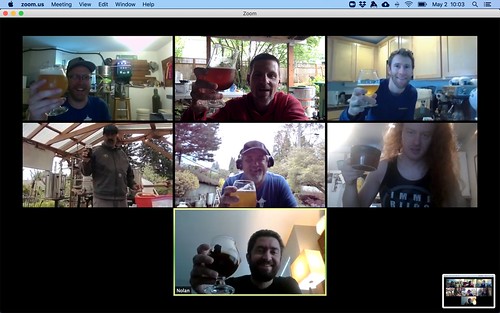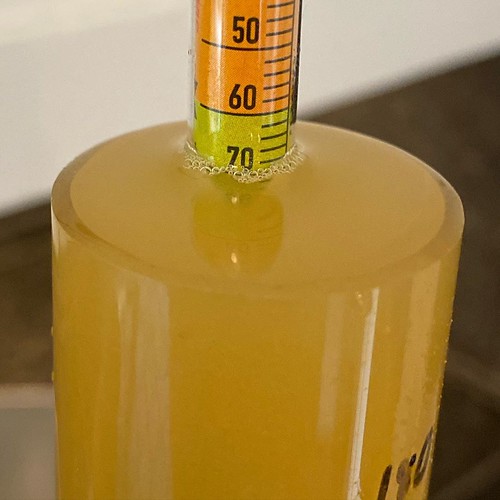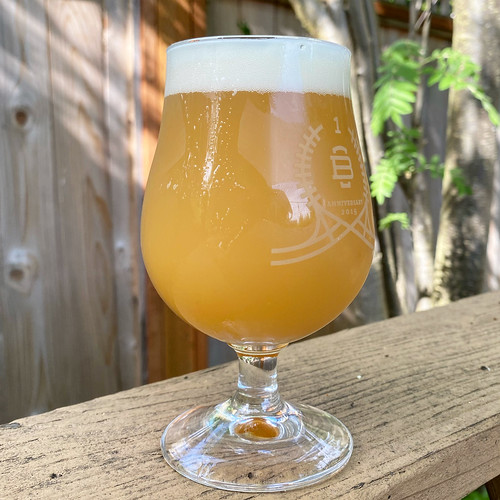Homebrew #99: Dubious Provenance
¶ by Rob FrieselOh yeah… my first brew of the great Coronavirus SARS CoV-2 COVID-19 Quarantine Shelter-in-Place Lockdown of 2020. This was a beer that I had queued up before all the Washington state “Stay Home, Stay Safe” stuff went into effect but… then there was the whole matter with my kegerator needing a re-build to deal with the COâ‚‚ leak and… Well, shit happens — right?
In any case, despite my 2020 goal to brew 6+ new-to-me styles, you also need to keep some reliable palate pleasers around. As a New England IPA, Dubious Provenance was just such a beer.

There were a couple of primary motivators with this one. First, I had several pounds of Briess 2-row from a 55 lb. sack that I was just dying to finish off. (Check.) There were some fun-looking experimental hops available on Yakima Valley and I thought it might be fun to play around — really go wild — in the spirit of new-to-me brewing things. (Check.) See also: Kveik yeast, anyone? (Another check.) Oh, and I wanted to see if I could dial-in my emerging preferred water profile for this style. (BIG CHECK.)
“OK sounds like we’ve got the materials and motivation; let’s brew a beer!”
Brew Day
Brew day was … much delayed. I did my shopping for this beer and Zondag Meisje on the same day, with the goal being to brew the latter in March (which I did), and the former soon after. But as alluded to earlier, first the shelter-in-place order hit, bringing some attendant disruption with it, and then I discovered that my kegging system had an impossible-to-find-but-definitely-leaking slow COâ‚‚ bleed somewhere. 1 But given that I had this age-sensitive drink-fresh style queued up, it wasn’t like I could just brew it and sit on it. That seemed irresponsible — so I did the next best (worst?) thing and simply delayed any brewing until I could wrap up the kegerator rebuild. 2 3
Nevertheless… brew day did come. And what better day to resume brewing than the 2020 AHA (Virtual) Big Brew Day? 4

I got my day started … well not early, but I wanted to have already mashed in by the time the Big Brew Day toast was happening (vide supra). But yeah…
Got mashed in only slightly north of my target temperature, had a plenty-acceptable pH reading at 5.22, and just let things go for the planned 90 minutes. Took my pre-boil gravity reading and… BeerSmith converted my 14.4ºBx to 1.058. A bit low but… “Sure, OK. It’ll be beer.”
Get it to boiling, add the bittering charge, etc.

From there? Chill to 180ºF for the 15 min. hop stand (2 oz. each of HBC 472 and HBC 586) — then chill down to about 80ºF.

Then 5.4 gallons went into the fermentor at 1.069.

Fermentation
I pitched the A43 Loki almost immediately. The guidance I’d gotten from friends was that this kveik strain throws some interesting esters when you ferment it warm. And by warm, we’re talking in the mid-80s ºF here.
The thermometer on my controller was reading 82.5ºF when I pitched, and then I locked it in at 84±2ºF. Just a single pack; no starter. (That was the other thing friends told me: that under-pitching wouldn’t be a big problem.)
I didn’t check the fermentor again on brew day, but the next morning (+18 hours after pitching), there was some vigorous activity in the blow-off bucket.
At +24, I added 3 oz. each of HBC 472 (PDF) and HBC 586 (PDF).
At +29 hours, I took my gravity reading: 8.8ºBx which BeerSmith converted to 1.014.
Gave it a couple more days and took another gravity reading at +79 (8.1ºBx → 1.009) and then again at +102 (same) and +127 (same again).
In other words, I suspect that the kveik strain may very well have hit F.G. in less than 72 hours, and possibly less than 48 hours. Even with a few more days of maturation, that hinted at grain-to-glass in about a week. And given that I wasn’t picking up any obvious fermentation faults here… “Why not go ahead and package it?”

Three more ounces each of HBC 472 and HBC 586 went into tied-off hop socks that went into the keg. Transfer the beer and put it on gas courtesy of that handy carbonation stone…
Overall Impressions
Recognizable as the target New England IPA style, and a nice incremental improvement over my previous two attempts (Lupulin-Industrial Complex and Expensive Chaos). Very enjoyable to drink. This is the kind of beer that friends-of-homebrewers would compare favorably to commercial examples and (after a second one) slur that you should shtart your own brewery, ya know? I wouldn’t go that far, but I do think it turned out pretty good.

AROMA. Moderately low grainy-sweet malt with hints of cracker and background honey-like accent. Medium-high hop notes overall: substantial pineapple and mango; distinct nectarine; moderate white peach; low but pronounced orange zest. Hints of guava and floral notes. Cedar? Some fruity notes could just as easily be esters as from hops. Mild but notable ethanol. No significant detectable off-aromas. Overall aromatic levels seem slightly low for a style that is supposed to have “intense” hop character, but neither is it dull or subdued.
APPEARANCE. Pale gold color. Hazy bordering on opaque as appropriate for the style; no noted particulates (e.g., hop matter or yeast). Dense white head pours foamy and meringue-like but settles into a persistent cordon — seems to collapse on the quick but easily re-roused. May be slightly over-carbonated.
FLAVOR. Malt flavors are low but present and mirror aroma; grainy-sweet with a crackery impression. Hop flavors also follow aroma: medium-high, with tropical notes dominating (pineapple, mango), followed by stone fruits (nectarine, peach), and Navel orange — flavor adds a medium-low element that’s evocative of raspberry. There’s also something in the aggregate flavors that suggests key lime pie. Bitterness is an IBU short of a firm medium and seems slightly high for style. Fermentation seems clean overall, with some of the fruity impressions just as easily ascribed to esters dias hops. The balance is decidedly hoppy, though not strongly bitter. Slight residual sweetness, but just enough to make it off-dry. No significant detectable off-flavors.
MOUTHFEEL. Medium-light body with a pleasantly “soft” character. Medium-high carbonation seems slightly more than style calls for — adds a of carbonic bite in the finish that contrasts with the otherwise soft feel. Moderate warming from the alcohol. Medium-low creaminess. No significant astringency (but not none either) — would characterize that as hop-derived, though it doesn’t veer into “hop burn”.
OVERALL IMPRESSION. Very good example of the style — though I wish I could judge this one blind as I’m tempted to give myself a score in the Excellent range and/but that feels like vainglorious bragging. Primary faults are that the alcohol seems to run slightly hot (this beer should probably be 1-2% ABV lower?) and the bitterness is a touch high when compared to the NEIPA standard-bearers. Nit-pick: might be slightly over-carbonated. Creaminess to the mouthfeel is pleasant and helps to round out the overall impression. Pleasant fruity flavors dominate, though hard to detect which are hop- and which are ester-derived. (Observation only! not a criticism.) No significant hop burn — so that’s nice. Apleasant-to-drink beer that could use some minor tweaks.
Other observations? Anything I would change?
- Be a little more deliberate about the grist composition next time. I played it fast and loose with the amount of 2-row — i.e., estimating rather than actually weighing it out — and if true that throws off the gravity, the balance with the IBUs, the overall proportion of high-protein adjuncts, etc.
- On that note, I’d consider dialing back the high-protein adjuncts a little bit. I’ve liked the 50/50 blend of flaked oat and wheat, but some recent reading suggests that pushing the proportion of these to 20% or higher may not actually be to the beer’s benefit. As planned these were at 20% of the grist composition; assuming I was short approximately 1 lb. of the base malt that’s still… less than 22%? Regardless… something to consider.
- Keep the kveik? I like what the kveik yeast did here, but I also think with so much going on in this beer that it might be fun to experiment with it something simpler and (dare I say…?) cleaner to get a clearer picture of what it is bringing to the table vs. the hops here. It also occurs to me that I have no idea if kveik yeast even have the enzymes to perform the so-called biotransformation dry hop.
- Those experimental hops were fun. (Aside: maybe I don’t eat enough stuff with coconut in it, but just like I claimed with Expensive Chaos, I think those claims are over-stated. Looking at you, HBC 472.)
- Drop the bittering addition by half, or possibly all together. I don’t want my NEIPA to have zero bitterness 5 but this one is a little on the high side. Maybe that wouldn’t have been the case if I wasn’t short on the O.G.? 6
- With this batch, I think I may have dialed in the water profile that I like for this style. Outside feedback would be good, but I suspect anything that comes out of that would just be tweaks. Otherwise I’m pretty satisfied with that.
- And of course (as always) keep chasing after cold-side Oâ‚‚ reductions!
Recipe
The all-grain (BIAB) recipe for Dubious Provenance is as follows:
Water Chemistry
Starting with the Seattle municipal water profile (carbon filtered) as a base:
| Ca | Mg | Na | SO4²- | Cl- | HCO3- |
|---|---|---|---|---|---|
| 68.0 | 16.7 | 15.9 | 80.8 | 121.1 | 22.9 |
Grist
87? lb. Briess 2-row Brewers malt 7- 2 lb. Thomas Fawcett Golden Promise
- 2 lb. Avangard Vienna malt
- 1 lb. 8 oz. flaked oats
- 1 lb. 8 oz. flaked wheat
Hop Schedule
- 1 oz. Warrior (30 min.)
- 2 oz. HBC 472 (15 min. steep/whirlpool at 180ºF)
- 2 oz. HBC 586 (15 min. steep/whirlpool at 180ºF)
- 3 oz. HBC 472 (dry hop; 24 hours after pitching)
- 3 oz. HBC 586 (dry hop; 24 hours after pitching)
- 3 oz. HBC 472 (keg hop)
- 3 oz. HBC 586 (keg hop)
Yeast
Imperial Organic Yeast A43 Loki (no starter)
Brew Day
- Collect 29.10 qt. water and heat to 157.6ºF. Mash in; hold at 147.9ºF for 90 minutes. No mash out.
- Remove filter bag from water. Squeeze filter bag to extract as much liquid as possible for wort. No sparge. Pre-boil volume should be 6.2 gallons.
- Bring to a boil. Boil for 30 minutes; follow hop schedule as described above.
- Cool to 180ºF and add the whirlpool hops. Steep for 15 minutes.
- Cool to 80ºF as rapidly as possible. Post-boil volume should be approx. 5.25 gallons.
- Aerate wort; pitch A43 Loki yeast.
- Start fermentation at approx. 80ºF.
Beyond Brew Day
- Pitch at 80ºF and set controller to 84±2ºF. Allow fermentation to complete (approx. 1 weeks).
- Add first dry hop addition 24 hours after pitching.
- Add second dry hop addition in the keg just prior to packaging. Carbonate to approx. 2.6 volumes.
- Enjoy!
Details
Dubious Provenance, a New England IPA by Tilde Gravitywerks
| Original Gravity | 1.069 |
| Final Gravity | 1.010 |
| ABV | 7.9% |
| Attenuation | 84.8% |
| IBU | 44 |
| SRM | 5 |
| Links | Flickr |
- Seriously: I blew threw a 20 lb. tank in about 35 days and no matter where I sprayed the foaming solutions, nothing ever seemed to bubble. WTH?[↩]
- Which turned out pretty well, thanks for asking![↩]
- It’s probably also worth noting here that I could have (should have?) “brewed” a mead or two during the intervening period BUT! did I mention that there were motivation problems? Quarantine livin’, etc.[↩]
- Which — aside! — this was the first year since I started brewing that I was able to actually do a Big Brew Day! In previous years, we’d always been traveling (Spring Break in VT!) or else I’d been judging at the Noonan. So that was exciting.[↩]
- LOL those “zero IBU” IPAs.[↩]
- Aside on that: as entered into BeerSmith, the O.G. was planned for 1.078. My actual O.G. was 1.069. I suspect that two things came into play here. First: I merely estimated the 2-row base malt at 8 lb., and it was probably closer to 7 lb. That would bring the estimated O.G. to 1.073. Second: whoops! I had the brew house efficiency set to 70% but given my own research, when my planned O.G. is above 1.065, I should be using 65% — change that and BeerSmith drops the estimated O.G. here to 1.067. That estimated vs. actual delta (1.067 vs. 1.069) is much easier to understand than what I otherwise had (1.078 vs. 1.069).[↩]
- This was the last of a 55 lb. sack. Given what I’d used in other brews, I’d estimated that I had about 8 lb. left — but the way the numbers played out? Probably closer to 7 lb.[↩]
Leave a Reply